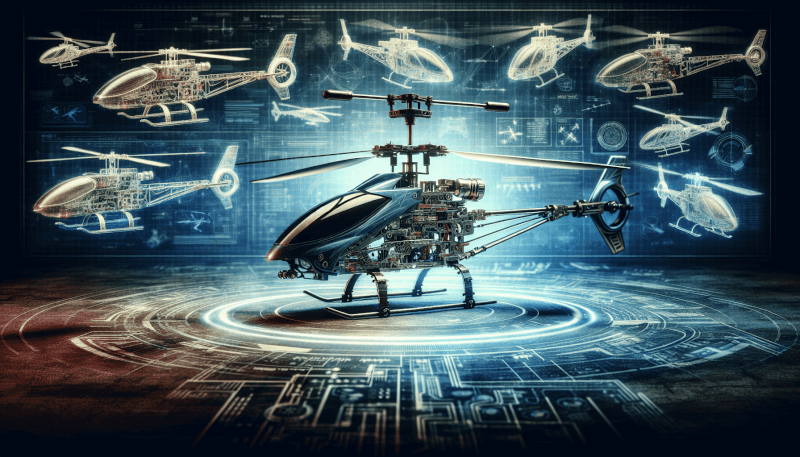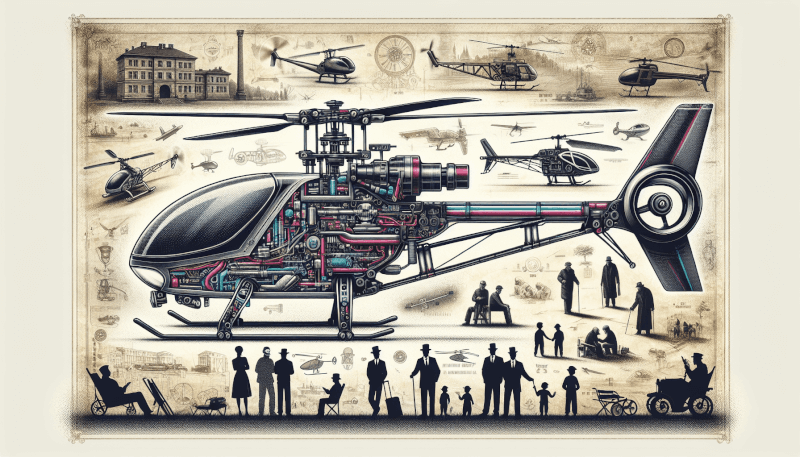In the fascinating world of remote-controlled (RC) aircraft, the evolution of RC helicopters has been nothing short of remarkable. What started as a mere hobby for radio enthusiasts has now transformed into an exhilarating sport, captivating both young and old alike. From the humble beginnings of simple single-rotor models to the advanced aerodynamic designs of today, the history of RC helicopters is a testament to the passion, ingenuity, and technological advancements that have propelled this hobby to new heights.
The Early Days of RC Helicopters
Invention of the First RC Helicopter
The origins of RC helicopters can be traced back to the 1860s when French inventor Gustave de Ponton d’Amécourt filed a patent for an “aerial apparatus.” Although this invention was never built, it laid the groundwork for future advancements in remote-controlled flight. However, it wasn’t until the mid-20th century that the first true RC helicopter was invented.
In 1938, a young inventor named Arthur Young developed the “Model 30,” which is widely considered the first successful RC helicopter. Powered by a gasoline engine, this early prototype featured a single rotor and limited control capabilities. Despite its simplicity, the Model 30 marked a significant milestone in the development of RC helicopters and set the stage for future advancements.
Development of Early RC Helicopter Models
Following the success of the Model 30, several other inventors and enthusiasts began experimenting with RC helicopter designs. These early models primarily focused on improving flight stability and control. One of the key pioneers during this period was Igor Sikorsky, the aviation pioneer known for his contributions to helicopter development. Sikorsky’s RC helicopters incorporated multiple rotors and advanced control systems, taking the technology to new heights.
RC Helicopters Enter the Hobby Scene
Introduction of RC Helicopters as Toys
In the late 1960s, RC helicopters started to gain traction as toys. Companies like Hirobo and Kyosho began producing affordable and user-friendly RC helicopter kits, making them accessible to a wider audience. These early toy-grade helicopters featured simplified controls and were often powered by electric motors, eliminating the need for gas engines.
The introduction of RC helicopters as toys sparked the imaginations of countless enthusiasts, both young and old. They provided a new form of entertainment and challenged individuals to master the art of flying. This shift toward recreational use paved the way for the rapid growth of the RC helicopter hobby.
Growing Popularity in the Hobbyist Community
As the technology advanced, RC helicopters became increasingly popular within the hobbyist community. Enthusiasts found joy in building, modifying, and flying these intricate machines. The hobbyist scene became a hub for knowledge sharing and innovation, with enthusiasts constantly pushing the boundaries of RC helicopter capabilities.
During this era, the demand for more advanced and high-performance models rose. Manufacturers responded by introducing upgraded components, such as more powerful motors and improved control systems. The advent of digital proportional radio control systems further enhanced the precision and responsiveness of RC helicopters, fueling their popularity among dedicated hobbyists.

Advancements in Technology
Introduction of Electric RC Helicopters
One of the major technological breakthroughs that revolutionized the world of RC helicopters was the introduction of electric power systems. Electric RC helicopters became a game-changer, offering quieter operation, cleaner power, and easier maintenance compared to their gasoline-powered counterparts.
Electric RC helicopters quickly gained popularity due to their affordability and accessibility. With advancements in battery technology, flight times increased, and the performance gap between electric and gas-powered models narrowed. Electric power systems also reduced the barriers to entry, allowing more people to join the hobby and experience the thrill of RC helicopter flight.
Improvements in Flight Stability and Control
Flight stability and control have always been essential aspects of RC helicopter operation. In the early days, achieving stable flight was a significant challenge, often requiring expert piloting skills. However, advancements in gyroscopic stabilization systems greatly improved the stability and ease of control for RC helicopters.
Gyroscopes, initially used in aviation for navigation purposes, were incorporated into RC helicopters to counteract unwanted movements and maintain a level flight. This development significantly aided pilots in controlling their helicopters, allowing for smoother and more precise maneuvering.
Additionally, advancements in control systems, particularly the adoption of flybarless technology, further enhanced the stability and responsiveness of RC helicopters. Flybarless systems eliminated the need for traditional flybars, reducing mechanical complexity and enhancing flight performance. These advancements made RC helicopter flight more accessible to beginners while providing experienced pilots with increased maneuverability and agility.
Miniaturization of RC Helicopter Components
RC helicopter technology has also witnessed remarkable miniaturization over the years. The shrinking size and weight of components, such as servos, receivers, and brushless motors, have allowed for the creation of smaller and more agile RC helicopter models.
Miniaturization has not only made RC helicopters more versatile but has also opened up new possibilities in terms of indoor flying and micro-class helicopters. Pilots can now experience the thrill of flying in tighter spaces and perform intricate maneuvers that were previously unthinkable.
RC Helicopters as Competitive Sports
Emergence of RC Helicopter Competitions
Just like any popular hobby, RC helicopters eventually found their way into the realm of competitive sports. RC helicopter competitions emerged as a way for enthusiasts to showcase their piloting skills and compete against fellow hobbyists.
Contests encompass various categories, including precision flight, freestyle, and 3D flying. In precision flight competitions, pilots are evaluated based on their ability to perform specific maneuvers with impeccable accuracy. Freestyle events allow pilots to exhibit their creativity and style through a choreographed routine, while 3D flying showcases the extreme maneuvering capabilities of RC helicopters.
These competitions not only provide a platform for pilots to demonstrate their skills but also foster camaraderie and community engagement within the RC helicopter hobby.
Formation of RC Helicopter Clubs and Organizations
With the rising popularity of RC helicopters, dedicated clubs and organizations started to form worldwide. These communities united like-minded individuals who shared a passion for RC helicopter flying, creating a supportive network for pilots of all skill levels.
RC helicopter clubs and organizations offer opportunities for members to gather, exchange knowledge, and engage in group flying sessions. They often host events, workshops, and training programs to promote skill development and foster a sense of community. These clubs also serve as platforms for collaboration, allowing members to collectively push the boundaries of RC helicopter technology and innovation.

Evolution of RC Helicopter Designs
Shift towards Collective Pitch Control
In the early days of RC helicopters, the primary method of controlling the aircraft’s vertical motion was through variable pitch control. However, the introduction of collective pitch control revolutionized the way RC helicopters maneuvered.
Collective pitch control allows pilots to adjust the pitch angle of all the main rotor blades in unison, enabling vertical movement control by adjusting the lift generated. This innovation provided pilots with greater control authority, enabling more dynamic flight maneuvers, such as sustained inverted flight and aerobatics.
Collective pitch control remains a fundamental feature in modern RC helicopters, contributing to their increased maneuverability and versatility.
Introduction of Flybarless Systems
The introduction of flybarless systems was another significant milestone in RC helicopter design. Flybarless technology eliminates the need for traditional flybars by utilizing advanced electronic stabilization systems.
By relying solely on electronic stabilization, flybarless systems simplify the mechanical setup of RC helicopters, reducing complexity and increasing reliability. These systems, often complemented by gyroscopes and accelerometers, provide greater stability, responsiveness, and agility during flight.
Flybarless systems have become standard in most modern RC helicopters, allowing pilots to push the boundaries of aerobatic maneuvers and 3D flight.
Use of Carbon Fiber Frames and Components
The advent of carbon fiber composite materials greatly influenced the design and construction of RC helicopters. Carbon fiber offers exceptional strength-to-weight ratio, making it an ideal material for constructing lightweight yet durable helicopter frames and components.
The use of carbon fiber frames allows RC helicopters to withstand the extreme stresses and vibrations associated with aggressive flight maneuvers. Carbon fiber components, such as rotor blades and tail booms, enhance responsiveness and reduce drag, significantly improving overall performance.
Carbon fiber’s widespread adoption has not only made RC helicopters more reliable and robust but has also contributed to their aesthetic appeal, with sleek, futuristic designs becoming increasingly prevalent.
Training and Skill Development
Importance of Simulators for RC Helicopter Training
For aspiring RC helicopter pilots, simulator training has become an invaluable tool for skill development. RC helicopter simulators provide a safe and cost-effective environment to practice flying and refine piloting techniques.
Simulators offer realistic physics models that accurately replicate the behavior of RC helicopters in various flight conditions. They allow pilots to practice maneuvers, build muscle memory, and develop the necessary hand-eye coordination without the risk of damaging their RC helicopters.
Simulator training provides a steep learning curve, allowing pilots to progress faster and minimize crashes when transitioning to real-life flying. It also enables pilots to experiment with different RC helicopter setups and simulate challenging scenarios, further enhancing their piloting skills.
Development of Formal Training Programs
As RC helicopters gained popularity, the demand for structured training programs grew. Recognizing the need for standardized training, various organizations and clubs established formal training programs for aspiring pilots.
These programs typically consist of theoretical instruction, practical flight training, and mentoring from experienced pilots. They cover a wide range of topics, including safety procedures, aerodynamics, pre-flight checks, radio control setup, and advanced maneuvering techniques.
Formal training programs not only promote safety and responsible flying but also accelerate the learning process, helping pilots progress from basic flight maneuvers to advanced aerobatics.

Popular RC Helicopter Models
Iconic RC Helicopter Brands
Numerous brands have made significant contributions to the RC helicopter industry throughout its history. Some notable iconic brands include Align, Blade, SAB, Synergy, and Mikado, each renowned for their innovative designs and quality craftsmanship.
These brands have played a vital role in pushing the boundaries of RC helicopter technology, introducing groundbreaking features and setting new benchmarks in performance. The competition between these brands has been instrumental in driving advancements in RC helicopter design, resulting in more capable and user-friendly models.
Notable RC Helicopter Models
Several RC helicopter models have left a lasting impact on the hobby, garnering widespread acclaim for their performance and innovation. The Align T-Rex series, Blade 450 X, Mikado Logo, and SAB Goblin are just a few examples of popular and influential models that have captivated hobbyists worldwide.
These models have not only showcased technological advancements but have also inspired pilots to strive for greater skill and creativity in their flying. Their success and popularity highlight the evolutionary journey of RC helicopters and the constant pursuit of excellence within the hobby.
RC Helicopter Innovations and Breakthroughs
Introduction of 3D Flying Capabilities
3D flying represents an advanced form of RC helicopter aerobatics that pushes the limits of what these machines can do in the air. It involves a combination of extreme maneuvers, such as flips, rolls, inverted flights, and tumbling maneuvers.
Advancements in RC helicopter design, specifically improvements in flight control systems and power-to-weight ratios, have allowed pilots to perform intricate 3D maneuvers with precision and confidence. Manufacturers have continuously refined their models to withstand the demands of aggressive 3D flying, offering helicopters specifically tailored to this adrenaline-fueled aspect of the hobby.
Integration of GPS and Autopilot Systems
GPS and autopilot systems have revolutionized not just the world of aviation but the RC helicopter hobby as well. These technological advancements have equipped RC helicopters with capabilities such as autonomous flight, waypoint navigation, and return-to-home functions.
Integration of GPS systems allows pilots to program predetermined flight paths, perform accurate aerial surveys, and execute complex missions with ease. Additionally, autopilot features enhance stability, making flying less demanding and more accessible to beginners.
The combination of GPS and autopilot systems has opened up new possibilities for RC helicopter applications, expanding the hobby’s reach beyond recreational flying.

RC Helicopters in Film and Photography
Use of RC Helicopters for Aerial Filming and Photography
The agility and maneuverability of RC helicopters make them ideal platforms for capturing stunning aerial footage. The film and photography industries have embraced this technology, utilizing RC helicopters to capture breathtaking shots that were once only possible with full-scale aircraft.
RC helicopters equipped with high-quality cameras offer filmmakers and photographers a cost-effective and flexible alternative to traditional aerial platforms. They can navigate tight spaces, fly at low altitudes, and provide dynamic perspectives, capturing angles that would be impossible for larger aircraft.
Their smaller size and maneuverability allow for intimate shots in challenging locations, bringing a new level of creativity to cinematography and photography.
Integration of High-Resolution Cameras
The evolution of digital camera technology has greatly influenced the capabilities of RC helicopters for aerial imaging. High-resolution cameras have become more compact, and their weight reduction has allowed them to be mounted on RC helicopters without compromising flight performance.
Integration of high-resolution cameras has transformed aerial imaging, enabling photographers and videographers to capture stunning details and remarkable image quality. Whether capturing landscapes, events, or wildlife, RC helicopters equipped with high-resolution cameras provide a unique perspective for visual storytelling.
The Future of RC Helicopters
Advancements in Battery Technology
Battery technology plays a crucial role in the future of RC helicopters. As battery energy density increases and charging efficiency improves, pilots can expect longer flight times and reduced downtime.
Advancements in battery technology also address concerns regarding environmental impact and sustainability. The shift toward cleaner and more efficient energy storage systems will contribute to the growth and acceptance of RC helicopters in a world increasingly focused on reducing emissions.
Integration of Artificial Intelligence
Artificial intelligence (AI) has the potential to transform the capabilities of RC helicopters. AI algorithms can enhance flight stability, optimize performance, and automate complex tasks, allowing for safer and more precise flying.
Intelligent collision avoidance systems, autonomous flight planning, and adaptive control algorithms are just a few examples of AI applications that could revolutionize the hobby. These advancements will make RC helicopters more user-friendly and further expand their potential range of applications.
Expansion into Commercial Applications
RC helicopters are no longer limited to recreational and hobbyist use. Increasingly, they are finding applications across various industries, including aerial photography, surveillance, search and rescue, and even package delivery.
As technology continues to advance, RC helicopters have the potential to become valuable tools for commercial purposes. With improved flight performance, reliable communication systems, and enhanced payload capacities, the future of RC helicopters holds promise in revolutionizing industries and opening up new opportunities for innovation.
In conclusion, the history of RC helicopters from their humble beginnings to their current state as a popular hobby and competitive sport is a testament to human ingenuity and the relentless pursuit of flight. From the invention of the first RC helicopter to the integration of advanced technologies, such as electric power systems, digital control systems, and GPS capabilities, RC helicopters have come a long way.
The future of RC helicopters looks bright, with advancements in battery technology, integration of artificial intelligence, and expansion into commercial applications. As technology continues to evolve, the possibilities for RC helicopters will only expand, captivating enthusiasts and pushing the boundaries of what is possible in the world of remote-controlled flight.



